Related Research Articles

Theft is the act of taking another person's property or services without that person's permission or consent with the intent to deprive the rightful owner of it. The word theft is also used as a synonym or informal shorthand term for some crimes against property, such as larceny, robbery, embezzlement, extortion, blackmail, or receiving stolen property. In some jurisdictions, theft is considered to be synonymous with larceny, while in others, theft is defined more narrowly. A person who engages in theft is known as a thief.
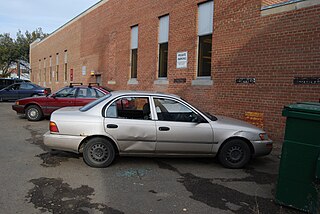
Motor vehicle theft is the criminal act of stealing or attempting to steal a motor vehicle. Nationwide in the United States in 2020, there were 810,400 vehicles reported stolen, up from 724,872 in 2019. Property losses due to motor vehicle theft in 2020 were estimated at $7.4 billion. There were 505,100 car thefts in the EU in 2019, a 43% decrease from 2008.

Shoplifting, shop theft, retail theft, or retail fraud is the theft of goods from a retail establishment during business hours, typically by concealing a store item on one's person, in pockets, under clothes or in a bag, and leaving the store without paying. With clothing, shoplifters may put on items from the store and leave the store wearing the clothes. The terms shoplifting and shoplifter are not usually defined in law. The crime of shoplifting generally falls under the legal classification of larceny. Shoplifting is distinct from burglary, robbery, or armed robbery. In the retail industry, the word shrinkage can be used to refer to merchandise lost by shoplifting, but the word also includes loss by other means, such as waste, uninsured damage to products and theft by store employees.

Art theft, sometimes called artnapping, is the stealing of paintings, sculptures, or other forms of visual art from galleries, museums or other public and private locations. Stolen art is often resold or used by criminals as collateral to secure loans. Only a small percentage of stolen art is recovered—an estimated 10%. Many nations operate police squads to investigate art theft and illegal trade in stolen art and antiquities.
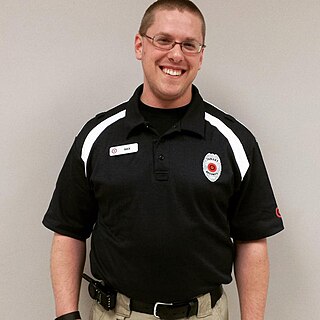
Retail loss prevention is a set of practices employed by retail companies to preserve profit. Loss prevention is mainly found within the retail sector but also can be found within other business environments.

A fence, also known as a receiver, mover, or moving man, is an individual who knowingly buys stolen goods in order to later resell them for profit. The fence acts as a middleman between thieves and the eventual buyers of stolen goods who may not be aware that the goods are stolen.
Property crime is a category of crime, usually involving private property, that includes, among other crimes, burglary, larceny, theft, motor vehicle theft, arson, shoplifting, and vandalism. Property crime is a crime to obtain money, property, or some other benefit. This may involve force, or the threat of force, in cases like robbery or extortion. Since these crimes are committed in order to enrich the perpetrator they are considered property crimes. Crimes against property are divided into two groups: destroyed property and stolen property. When property is destroyed, it could be called arson or vandalism. Examples of the act of stealing property is robbery or embezzlement.
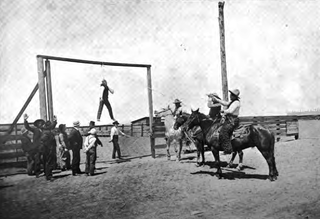
Horse theft is the crime of stealing horses. A person engaged in stealing horses is known as a horse thief. Historically, punishments were often severe for horse theft, with several cultures pronouncing the sentence of death upon actual or presumed thieves. Several societies were formed in the United States to prevent horse theft and apprehend horse thieves. However, horse theft continues to occur throughout the world, as horses are stolen for their meat, for ransom, or in disputes between their owners and other persons. Horse theft today is comparable to automobile theft, a crime punishable by felony jail time.
Organized retail crime (ORC) refers to professional criminal enterprises ranging from regional gangs to international crime rings and other organized crime focussing on retail environments. Operations include truckjacking, shoplifting, smash and grab, cargo theft, and cargo diversion. One person acting alone is not considered an example of organized retail crime. Working in teams, some create distractions while others steal items judiciously, indiscriminately or violently. Often, they are stocking up on specified items at the request of the organized crime or gang leader. It is not uncommon for the criminals to have accomplices working in the retail store or corporation.
Doris Marie Payne is an American convicted jewel thief.
For a variety of reasons, convenience stores are often popular targets for a variety of crimes, most notably shoplifting and robbery. In some cities, convenience store crime has become such a problem that special task forces have been created or some stores have been completely closed down. American convenience stores are often direct targets of armed robbery. In some areas of the United States, it is not unusual for clerks to be working behind bulletproof glass windows, even during daylight hours. Some convenience stores may even limit access inside at night, requiring customers to approach a walk-up window specifically for such situations to make purchases. The main dangers are that almost all convenience stores only have one person working night shift, most of the transactions are in cash, and easily resold merchandise, such as liquor, lottery tickets, and cigarettes are on site.
Baby Jesus theft is the theft of figurines of the infant Jesus from outdoor public and private nativity displays during the Christmas season. It is an "enduring practice" according to New York Times journalist Katie Rogers, "believed to be part of a yearly tradition, often carried out by bored teenagers looking for an easy prank." Sometimes these are stolen for resale, other times the associated pranks are more involved and include dropping it off somewhere else.
Return fraud is the act of defrauding a retail store by means of the return process. There are various ways in which this crime is committed. For example, the offender may return stolen merchandise to secure cash, steal receipts or receipt tape to enable a falsified return, or use somebody else's receipt to try to return an item picked up from a store shelf.
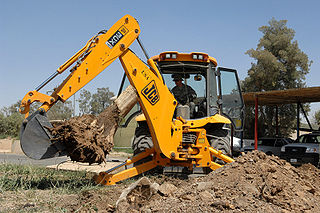
Construction equipment theft, is the criminal act of stealing or attempting to steal construction equipment, including all type of heavy equipments. Construction equipment theft has been recognized as a significant problem in the United States and elsewhere in the world, including Canada, Australia, Europe, and Japan.
Theft from libraries of books, historical documents, maps and other materials from libraries is considered a significant problem. One study commissioned in the UK estimated the average loss rate of libraries to theft at 5.3%.

Until 2019, GadgetTrak was a company based in Portland, Oregon, that developed theft recovery and data protection software. The company was founded in February 2007 by Ken Westin with the launch of the first theft recovery product for USB mass storage devices, tracking stolen devices including iPods, flash drives, digital cameras and other devices when connected to a computer. The company was issued a patent for the technology on February 24, 2009. GadgetTrak's technology was featured during a special segment by Dateline on iPod theft where they tracked stolen iPods and confronted the thieves. A customized version of the technology was embedded in FLIR thermal imaging cameras as part of an exclusive licensing agreement under the name ThermaTrak utilized for both theft recovery as well as export controls.

Bicycle theft is the crime of stealing a bicycle. It is a common crime due to the relative ease of reselling bicycles, which have a large second-hand market. This makes the crime attractive to those needing to obtain currency quickly, such as people with substance addictions. Bicycles are also easily accessible, often being locked up outside in public places in urban areas. Despite the developed market of bicycle locks, it is estimated that millions of bicycles are stolen every year. Thieves use a variety of methods to bypass locks, including taking advantage of bicycle owners' poor locking practices. Bicycle owners can take action to reduce the chances of theft, including utilising facilities such as bicycle lockers and parking racks.
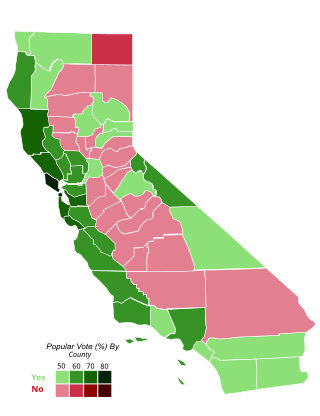
Proposition 47, also known by its ballot title Criminal Sentences. Misdemeanor Penalties. Initiative Statute, was a referendum passed by voters in the state of California on November 4, 2014. The measure was also referred to by its supporters as the Safe Neighborhoods and Schools Act. It recategorized some nonviolent offenses as misdemeanors, rather than felonies, as they had previously been categorized.

John Mark Tillmann was a Canadian art thief and white supremacist who, for over two decades, stole over 10,000 antiques and art objects from museums, galleries, archives, and antique shops mainly in Atlantic Canada.
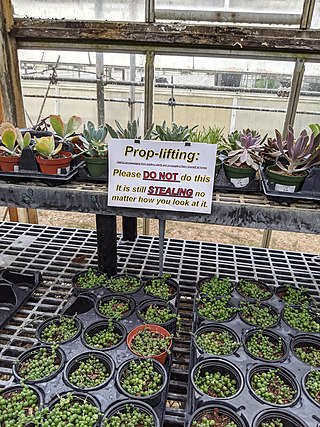
Proplifting is the practice of taking discarded plant material and propagating new plants from them. Some proplifters engage with the hobby as a form of self-administered horticultural therapy.
References
- 1 2 3 Constant, Paul, "Flying Off the Shelves: The Pleasures and Perils of Chasing Book Thieves", The Stranger , February 26, 2008, retrieved December 20, 2009
- ↑ Federman, Stan, "Book Shop Like Candy Store to Its Owner", article, The Oregonian of Portland, Oregon, April 9, 1992, retrieved December 20, 2009
- 1 2 3 Leon, Madeline (2018-05-29). "Approximately $60,000 in Merchandise Stolen Annually from UCSD Bookstore on Average". UCSD Guardian. Retrieved 2022-11-02.
- 1 2 3 4 5 6 Rabb, Margo, "Steal These Books", essay, The New York Times Book Review, December 20, 2009, retrieved same day
- 1 2 3 Kean, Danuta (2017-01-09). "Stolen good books: why Canadian thieves outclass the British". the Guardian. Retrieved 2022-11-02.
- ↑ Rosenbaum, Ron, "Shoplift Lit: You Are What You Steal", column, The New York Observer , September 26, 1999, retrieved December 20, 2009
- 1 2 3 4 5 "Book Stealing" Archived 2010-06-13 at the Wayback Machine , segment transcript, On the Media , December 23, 2005, retrieved December 20, 2009
- 1 2 Brown, Mick, "Jeffrey Eugenides: Enduring love", The Telegraph, January 5, 2008, retrieved December 20, 2009
- 1 2 "Actor Ray Buffer Accused of Stealing Comics, Store Says It's on Video". TMZ. Retrieved 2022-11-02.
- ↑ "Salmon Arm bookstore catches man on camera allegedly stealing Marvel and DC comics". INFOnews. Retrieved 2022-11-02.
- ↑ Padilla, Ishshah (2022-04-22). "Caught on camera: Man seen stuffing comics down his pants in Clovis". KMPH. Retrieved 2022-11-02.
- ↑ Bythell, Shaun (2020-11-27). "Passing sentences … what's the worst kind of book thief?". the Guardian. Retrieved 2022-11-02.
- 1 2 3 4 5 Rosen, Judith (2004-05-17). "Literary Thugs And Book Thieves". Publishers Weekly. 251 (20): 19–20.
- 1 2 Evans, Holly (2022-10-29). "Serial thief jailed after stealing £2,000 worth of books at London Waterstones". MyLondon. Retrieved 2022-11-02.
- ↑ Williams, Owen (27 October 2022). "Confess, Fletch Star Jon Hamm Used To Shoplift Fletch Books – Exclusive". Empire. Retrieved 2022-11-02.
- 1 2 Codd, Nathan, "Theft an ongoing issue for bookstore" Archived 2010-07-01 at the Wayback Machine , SFXpress, September 16, 2009, retrieved December 20, 2009
- 1 2 Romano, Carlin, "The Problem of Catching and Booking the Book Shoplifters", The Philadelphia Inquirer, June 26, 1991, retrieved via Newsbank.com, December 20, 2009
- ↑ Rivenburg, Roy, "Thieves Rip Off Book Stores in Growing Volume", Buffalo News, "Lifestyles" section, p E1 (story reprinted from The Los Angeles Times), October 25, 1992; retrieved via Newsbank website, December 20, 2009
- ↑ Dake, Janet (2017-09-18). "Campus police arrest serial shoplifter". The Louisville Cardinal. Retrieved 2022-11-02.
- ↑ Rosen, Judith (24 May 2004). "Fighting Back Against Theft." Publishers Weekly, Vol. 251, Issue 21.